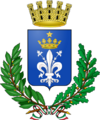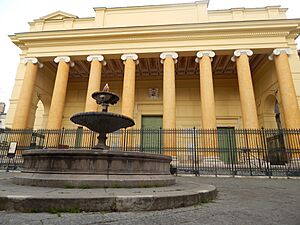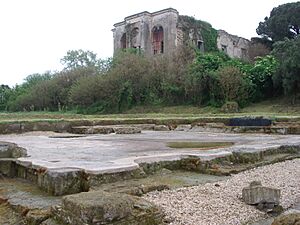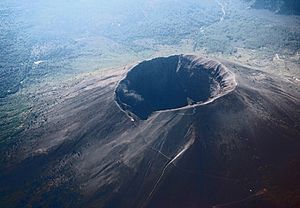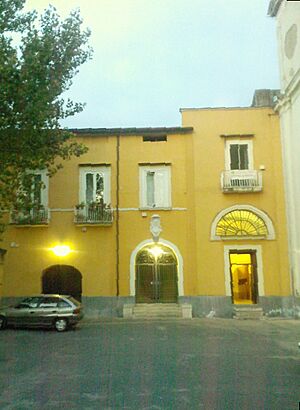Acerra facts for kids
Quick facts for kids
Acerra
|
||
|---|---|---|
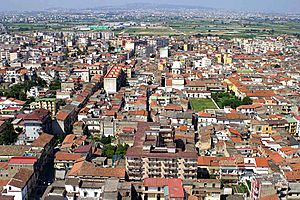
Aerial view of Acerra
|
||
|
||
| Country | Italy | |
| Region | Campania | |
| Frazioni | Gaudello, Pezzalunga | |
| Area | ||
| • Total | 54.71 km2 (21.12 sq mi) | |
| Elevation | 26 m (85 ft) | |
| Population
(31 December 2017)
|
||
| • Total | 59,910 | |
| • Density | 1,095.05/km2 (2,836.2/sq mi) | |
| Demonym(s) | Acerrani | |
| Time zone | UTC+1 (CET) | |
| • Summer (DST) | UTC+2 (CEST) | |
| Postal code |
80011
|
|
| Dialing code | 081 | |
| Patron saint | St. Cuono and Conello | |
| Saint day | 29 May | |
Acerra is a town in southern Italy, located in the Metropolitan City of Naples. It's about 15 kilometers (9 miles) northeast of Naples, the capital city of the Campania region. Acerra is part of a flat area known as the Agro Acerrano plain.
Contents
History
Acerra is one of the oldest cities in its region. It was likely founded by the Osci people and called Akeru. It first appeared in history as an independent city during a big war between the Campanians, Latins, and Rome. In 332 BC, Acerra and other Campanian cities became Roman citizens, but without the right to vote. Later, they gained full Roman citizen rights.
During the Second Punic War, Acerra stayed loyal to Rome. Because of this, the city was attacked by Hannibal in 216 BC. The people left their homes, and the city was destroyed. After Hannibal left Campania, the people of Acerra returned and rebuilt their city in 210 BC with Rome's help.
Acerra was a Roman base during the Social War in 90 BC. It was attacked by a Samnite general but fought back strongly. The city was known for its fertile land, but floods from the Clanius river often caused problems. Later, the Roman emperor Augustus sent a group of settlers to Acerra.
In 826, the Lombards built a castle here, but it was later torn down. In 881, the city was attacked by the Saracens. Acerra then became a Norman area with its own count. For many years, it was part of the Kingdom of Naples and ruled by different families.
On October 1, 1943, during World War II, soldiers from the Hermann Göring Division sadly killed almost 90 civilians, including children and women. A memorial has been built to remember these victims.
Modern Challenges
From the 1990s to the 2000s, Acerra faced a big problem with trash. This was because of illegal dumping by members of the Camorra, a crime group. Much of this waste was dumped in the area between Acerra, Nola, and Marigliano, which became known as the "Triangle of Death".
A study in 2004 showed that the number of cancer deaths in this area was higher than the average in Europe. To help with the trash problem, an incinerator (a facility that burns waste) was built in Acerra in 2009. It cost over €350 million and can burn 600,000 tons of waste each year, producing enough energy to power 200,000 homes.
Even after the incinerator was built, there was another trash crisis in 2011. More than 2,000 tons of trash were left uncollected. Troops were sent in to help clean up the city.
Cool Places to See
| Place Name | What's Interesting About It | Pictures |
|---|---|---|
| Acerra Cathedral | This cathedral was built on top of an old temple dedicated to Hercules. It was rebuilt in the 1800s and has beautiful Baroque paintings from the 1600s. The Bishop's Palace is right next to it. | |
| Archaeological area of Suessula | This was a settlement from before Roman times, located in the Campania plains. Since 1996, Salerno University has been studying the area. They found that people probably knew about this ancient site as early as the early 1900s. | |
| Mount Vesuvius | This famous volcano is still active and sits near the Gulf of Naples. Mount Vesuvius last erupted in March 1944. It's considered one of the most dangerous volcanoes because about 3 million people live within 20 miles of it. | |
| Pompeii | On August 24, 79 CE, Mount Vesuvius erupted, covering Pompeii in ash and volcanic debris. This preserved the city, keeping it "frozen in time" until it was discovered in the 1700s. At the time of the eruption, about 10,000 to 20,000 people lived there. Pompeii offers an amazing look into daily life in Roman times. |
Culture
Architecture
Acerra has many different kinds of buildings. You can see modern train stations like the Napoli Afragola Station, which was designed by Zaha Hadid Architects in 2017. You can also find older buildings like the Acerra Cathedral.
Since Acerra is close to Naples, it shares many of its building styles. These include influences from the Roman Empire, the Renaissance, and the Baroque and Neoclassical periods. Many buildings are made from a special yellow-grey stone called Neapolitan Yellow Tuff Stone. This stone was also used to build the Acerra Cathedral.
Food
Acerra is a great place for delicious homemade food. Its neighbor, Naples, is even known as the birthplace of pizza! You can find many kinds of food, including baked, fried, and grilled dishes.
The Margherita pizza is very popular here. It was created to show the colors of the Italian flag: red from tomatoes, green from basil, and white from mozzarella cheese. Another well-known dish is Neapolitan pizza, which is a folded pizza filled with ricotta cheese, tomatoes, mozzarella, and peppers. You can also easily find pasta, coffee, and caprese salad.
Economy
After World War II, Italy's economy was very weak. However, it has grown to become one of the strongest in the world today. The biggest industries that help Italy's economy are chemicals and textiles. After the war, Italy's economy grew quickly because it could make and export many goods, thanks to its open trade policies.
Tourism is another big part of Italy's economy. While farming isn't its strongest area, Italy is one of the top countries in the world for producing olive oil. Other products that Italy exports include rice, tomatoes, and wine. However, Italy's economy does have some challenges, like not having many raw materials or energy sources, which means it has to import them.
In March 2020, people in Acerra were told to stay home because of the coronavirus pandemic. Since Acerra is a small town, some residents were unsure about the virus. In late March, a woman arrived in Acerra after traveling from Lombardy, which was where the virus first spread widely in Italy. She arrived on March 9, the day after the lockdown was announced.
The mayor of Acerra, Rafaele Lettieri, spoke about this issue without naming the woman. The woman then responded on Facebook, saying she had followed all the rules, including self-isolating. After the mayor's statement, some residents of Acerra went into the streets to say they wanted the woman to leave town.
Climate
Monthly Average Temperatures
The warm season in Acerra lasts for almost three months, from mid-June to mid-September. During this time, the average daily high temperature is usually above 83 degrees Fahrenheit. August is typically the hottest month, with average low temperatures around 69 degrees Fahrenheit and average highs around 88 degrees.
The colder season lasts for about four months, from late November to late March. The typical high temperature during this time is 62 degrees. January is the coldest month, with average low temperatures around 41 degrees Fahrenheit and highs around 55 degrees.
| Average | January | February | March | April | May | June | July | August | September | October | November | December |
|---|---|---|---|---|---|---|---|---|---|---|---|---|
| Average High (Fahrenheit) | 55° | 56° | 61° | 67° | 75° | 83° | 88° | 88° | 81° | 73° | 64° | 57° |
| Average Temperature (Fahrenheit) | 48° | 48° | 53° | 58° | 66° | 74° | 79° | 79° | 72° | 64° | 56° | 49° |
| Average Low (Fahrenheit) | 41° | 41° | 45° | 50° | 57° | 64° | 69° | 69° | 63° | 56° | 48° | 43° |
Weather
Acerra does not get a lot of precipitation (rain or snow). A "wet day" is when there is at least 0.04 inches of precipitation. November is usually the wettest month, with about 10 "wet days." During the wet season, less than a fourth of the days typically receive this amount of precipitation. Acerra can also be humid, but the humidity changes a lot throughout the year. The more humid months are usually from early June to late September.
Getting Around
There are many ways to travel in Acerra and get to nearby attractions. You can use taxis, walk, take a bus, use the metro, or drive a car. In the nearby city of Naples, many sights are close together, so walking is often the cheapest and best way to get around.
Taxis can be expensive, as the cost goes up the farther you travel. Buses are known for not always being on time. The metro has trains that run above or below ground. It's often used by people going to work or school, and it's a good way to travel longer distances for a reasonable price. Driving a car is not very common for visitors because you need an International Driving Permit to drive in Italy.
Safety in the Area
While Acerra has become safer, it's important to know that crime and gangs can be more common in southern Italy. One factor that can contribute to crime in Acerra is that many children in the town are not enrolled in school. In the 1990s, a major crime group called La Camorra was very active.
Even though the area isn't usually violent, there is a lot of organized crime. In Italy as a whole, the rate of serious crimes is actually lower than in places like New York City. Groups involved in organized crime are often called the "Mafia".
See also
 In Spanish: Acerra para niños
In Spanish: Acerra para niños


